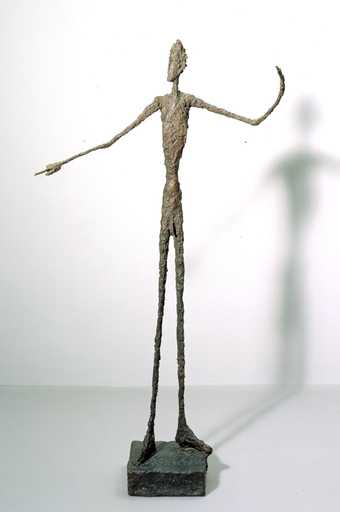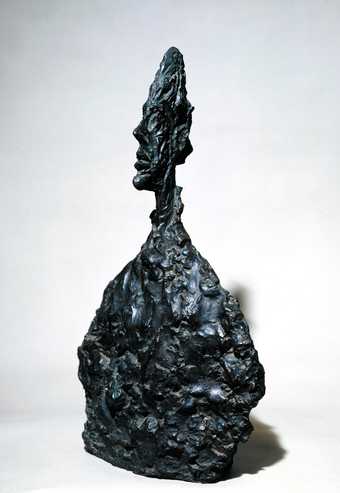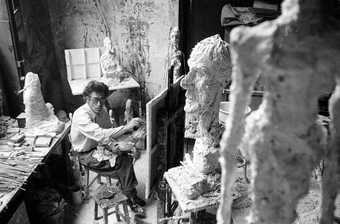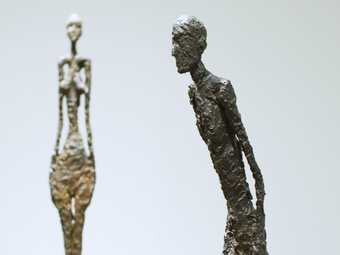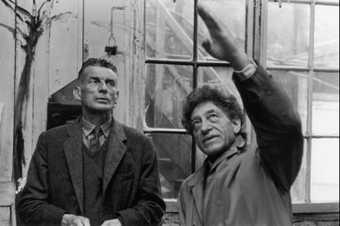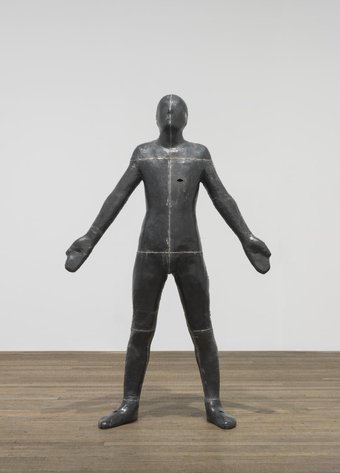
Sir Antony Gormley OBE RA
Untitled (for Francis)
(1985)
Tate
Frances Morris and Sir Antony Gormley sit down to discuss Alberto Giacometti's career and the role of sculpture
Frances Morris: Alberto Giacometti, as an artist, is instantly recognisable. He’s somebody we associate with the striking, skinny figures, the walking man, the pointing man. But his career was very complex. He was somebody who had a conventional studio practice and worked with a model, but from early in his career he was really obsessed with questions around form, modelling, and abstraction. He became very involved in surrealism, and cubism touched him.
Like Giacometti, you have created an instantly recognisable oeuvre. The sculptors you habitually talk about are other greats, such as Rodin, Epstein, Brancusi, and I think we can bring Giacometti into that family as well. Would you agree?
Antony Gormley: Firstly, thank you for an extraordinary exhibition, Frances. We owe you, Catherine Grenier and your team a debt of gratitude for showing such well-known works to us anew.
And yes, Giacometti’s work has been a great influence. What you can see in the exhibition is the character of this man who comes from a mountain, arrives in Paris and has this simply insatiable appetite for the possibility of sculpture. You can sense his obsession. You can see the inspirations he draws on, from Surrealism, Cubism, Fauvism and ancient Egypt, to the early farmers and nature. In the French philosopher Jean-Paul Sartre’s great text, Giacometti becomes the quintessential existential man-on-his-own but that is a myth because I think Giacometti is an intensely social being. He’s intensely engaged with his subjects but also with sculpture and borrows and steals from others of his generation, as well as making alliances and contrasts with the deep past.
What remains extraordinary about Giacometti is that every single one of his works looks like the first thing he has made. I want to make a body that has that same quality of freshness.
FM: What do you think Giacometti is trying to say through his work?
For me, Giacometti remains an example of the artist who is full of the possibility of art, and wants to find something that sculpture can do.
Antony Gormley
AG: Giacometti was looking for a job worthy of an artist in the 20th century and he wanted to grasp what it is that sculpture, in particular, can do. He asks what can be made in material that will change the way we feel or think, or that expresses not so much what something looks like, but the very process of looking. For instance, in Walking Man I there is no bending at the knee in the figure, in fact there’s hardly any bending at the knee anywhere. Instead Giacometti refers to idea of motion but actually just insists that sculpture is still and we’ve got to make its stillness count: that’s the job.
FM: You’re an artist who deals with scale. How would you think about Giacometti in relation to scale? Because it is something that is endlessly problematic for him, or fascinating for him.
AG: Giacometti talks about ‘l’apparence’: the notion that an artist has to grapple with giving a true and accurate account of what it means to see. His attempt to do just that is what produced the decrease of scale in his work. He took it to the point at which things were almost disappearing in his fingers; at the point when he felt he was approaching an accurate depiction of seeing a body at a distance – it disintegrated. You can see this in the exhibition, in that wonderful head of Diego that’s probably only 12mm high.
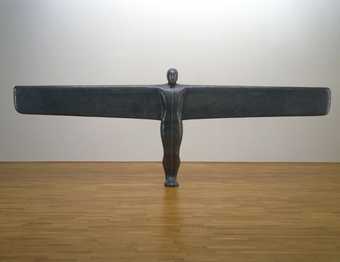
Sir Antony Gormley OBE RA
A Case for an Angel III
(1990)
Tate
It’s important to recognise that this is to do with the very powerful idea that the object cannot be seen independently from the space that divides it from the viewer. Giacometti is continually tackling and interrogating this tension between mass and space, the body’s dependency on that which it is not.

Alberto Giacometti The Dog 1951 Kunsthaus Zürich, Alberto Giacometti Stiftung (inv. GS47) © Alberto Giacometti estate / ACS+DACS in the UK, 2017
What is a challenge worthy of the life of an artist now in the twenty-first century? I want to make a credible account of what it means to be alive, to be human.
Antony Gormley
FM: I believe that there’s a continuous sort of beginning again, every work is a beginning again. He’s never comfortable with the results. Do you see this within Giacometti’s work?
AG: Yes, absolutely. You can see that obsession, that mania in the work. There’s an inherent admission that any attempt to grasp reality is doomed to failure but also an assertion that our duty is to make sense of our perceptions of the world and share what we find. So, Giacometti follows the Beckettian “fail, fail again, fail better” recipe. He was continually going back to the root of what it means to see through making, always attempting and always starting again.
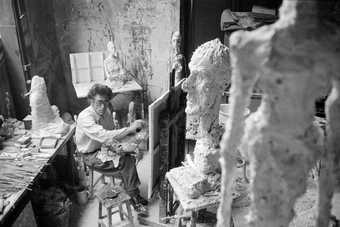
Giacometti painting in his Paris studio, in the foreground "La Grande Tête", 1958
Photographs by Ernst Scheidegger © 2017 Stiftung Ernst Scheidegger-Archiv, Zurich
FM: Giacometti worked from the same studio for over 40 years, obsessively returning to the same premise every morning, every evening, unfinished, dissatisfied. In your work, can you articulate what drives you from one thing to another?
AG: I continue to ask the same question as Giacometti: what is a challenge worthy of the life of an artist now?
Unlike Giacometti, I believe that the answer, now, is more about being than looking. In my work, I am trying to find an alternative to the anatomical, to representation and I look at the body less as an object than a place.
I'm really trying to find an alternative to bone, muscle and skin. I want to detach the notion of being from the accidents of appearance and make something that gives an account of presence, of being present.
Giacometti was quintessentially an artist who wanted to reinvent the world on his own terms, so the studio was a sacred, private space in which he made original objects that tested his relations with everything. But that little time capsule, the intense personal space of the studio, resisted the world. In the 21st century, there is a huge need for imaginative objects to help us negotiate a collective future and the freedoms that artists like Giacometti and Brancusi took for themselves to reinvent the world now have to be shared. It’s happening, we see it right here at Tate Modern, in this new and extraordinary degree of collective engagement in the spaces of art, but it couldn’t have happened without the example of artists like Giacometti.

